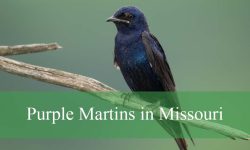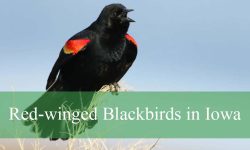Dragonflies are among the most fascinating insects you can find in Illinois. With their shimmering wings and agile flight, they bring life and color to lakes, rivers, and wetlands throughout the state.
Illinois is home to a wide variety of dragonflies, ranging from vibrant skimmers to powerful darners and elegant clubtails. Each species has unique features, behaviors, and habitats that make them stand out.
In this guide, we’ll explore 25 types of dragonflies in Illinois, along with their identification, behaviors, and where you’re most likely to spot them.
Different Types of Dragonflies Found in Illinois
Eastern Pondhawk (Erythemis simplicicollis)

The Eastern Pondhawk is a medium-sized dragonfly frequently found across Illinois. Males are a striking powdery blue with green faces, while females and young males are bright green with black striping on the abdomen. This sexual dimorphism makes them easy to identify when both sexes are present in the same area.
They measure about 1.5 to 2 inches long with clear wings. Unlike larger darners, they prefer perching low on vegetation near water, where they wait to ambush prey. Their aggressive hunting style allows them to catch other dragonflies, damselflies, and various flying insects.
Eastern Pondhawks are known for their territorial behavior. Males defend sunny patches along pond edges and chase away rivals. Females, meanwhile, often avoid male-dominated areas until they are ready to mate, after which they deposit eggs directly into the water.
In Illinois, they are abundant during the summer months, especially in still or slow-moving waters such as farm ponds, lakes, and wetlands. Their adaptability makes them one of the most common dragonflies throughout the state.
Common Green Darner (Anax junius)

The Common Green Darner is one of the most recognizable dragonflies in Illinois. It has a bright green thorax and a long abdomen that is often blue in males and brownish in females. With a wingspan of about 3 to 4 inches, it is one of the larger dragonflies in the state, making it easy to spot near lakes, ponds, and wetlands.
Identification is straightforward due to its bold green coloration and the distinctive bull’s-eye mark on the face. Its large size and swift, direct flight make it stand out among other dragonflies. Adults are often seen hovering or patrolling open waters, especially during sunny days.
Behaviorally, the Common Green Darner is a strong flier and a long-distance migrant. Some populations migrate from the northern United States, including Illinois, all the way to the southern states or even Central America in fall. They are voracious hunters, feeding on mosquitoes, midges, and other small insects while flying.
In Illinois, this species is most common from spring through late summer. They thrive in habitats with abundant aquatic vegetation, such as marshes and ponds, where females lay eggs. Both adults and larvae play an important role in controlling insect populations.
Blue Dasher (Pachydiplax longipennis)
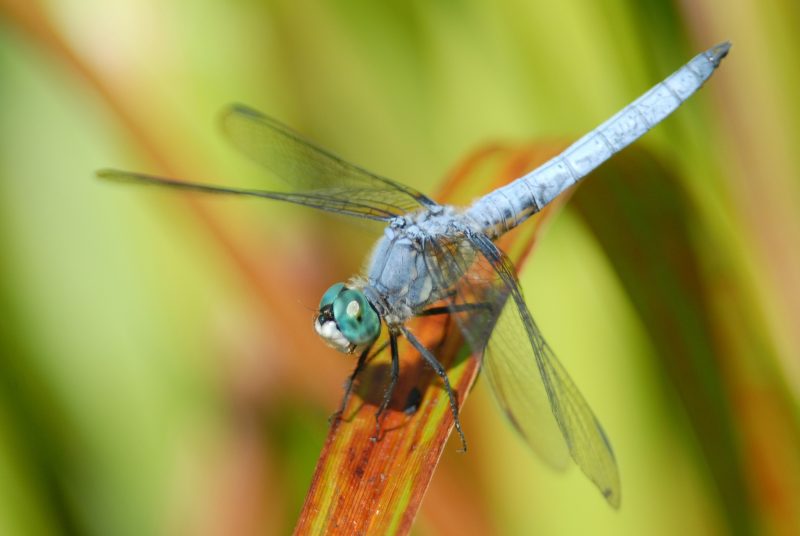
The Blue Dasher is a small but charismatic dragonfly seen in many parts of Illinois. Males have bright blue bodies with white faces and striking black-tipped abdomens, while females and juveniles are brown with yellow striping. Their compact size, averaging 1.5 inches, makes them smaller than many other dragonflies.
They are easy to identify by their perching habits. Blue Dashers often rest on reeds, twigs, or lily pads close to the water’s edge, darting out quickly to snatch insects in flight. Their flight is quick and darting, hence the name “dasher.”
Behaviorally, they are opportunistic feeders, consuming a variety of flying insects, including mosquitoes and flies. Males are also highly territorial, frequently confronting intruders in their chosen hunting area. Despite their small size, they are bold and active hunters.
In Illinois, Blue Dashers thrive in ponds, marshes, and slow streams from late spring through early autumn. Their adaptability allows them to colonize both rural wetlands and urban parks with water features, making them one of the most observed dragonflies in the state.
Widow Skimmer (Libellula luctuosa)
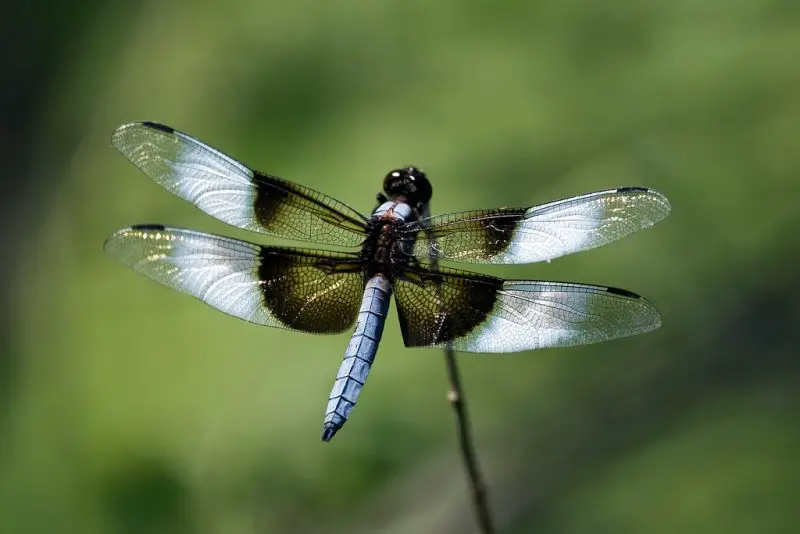
The Widow Skimmer is a medium to large dragonfly with distinctive wing patterns. Males have broad black bands at the base of their wings, followed by white patches, while females only display the black bands. Their bodies are typically brown in females and powdery blue in mature males.
With a wingspan of about 2.5 to 3 inches, they are highly visible when gliding over ponds and lakes. Their slow, floating flight pattern, combined with the striking wing markings, makes them easy to identify even from a distance.
They are sit-and-wait predators, often perching on vegetation near water and sallying out to capture prey. Their diet consists mainly of small flying insects, which they catch midair. Males maintain territories and display prominently to attract females.
In Illinois, Widow Skimmers are commonly found in still or sluggish waters, especially where emergent plants like cattails provide perches. They are most active in summer and are a favorite among nature watchers due to their beautiful wing markings.
Twelve-spotted Skimmer (Libellula pulchella)
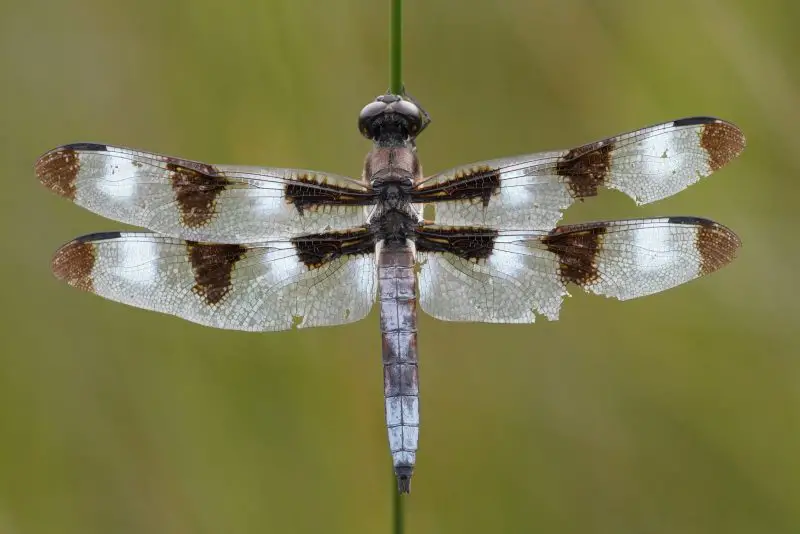
The Twelve-spotted Skimmer is one of the most striking dragonflies in Illinois. Males have black spots at the base, middle, and tip of each wing, making twelve in total. Additionally, mature males have white patches between the black spots, giving them a distinctive checkered look. Females lack the white patches but retain the black spots.
This species is medium to large in size, with a wingspan of around 3 inches. Their flight is strong and steady, often circling over open water or patrolling along the edges of ponds and lakes. Their bold wing pattern makes them stand out in flight.
Behaviorally, Twelve-spotted Skimmers are both territorial and social. Males defend territories but are often seen in groups, unlike some solitary species. They perch frequently on tall vegetation, making them easy to observe. Their diet includes mosquitoes, gnats, and small flying insects.
In Illinois, they are widely distributed in summer months and prefer open ponds, lakes, and marshes. Their abundance and striking appearance make them a popular subject for photographers and dragonfly enthusiasts across the state.
Black Saddlebags (Tramea lacerata)

The Black Saddlebags is one of the most distinctive dragonflies in Illinois due to the large black patches at the base of its hindwings that resemble saddlebags. Its body is slender and dark, usually black or very deep brown, with clear wings except for the characteristic markings. Measuring around 2.5 inches, this dragonfly is easily identified in flight.
Unlike many other dragonflies, the Black Saddlebags spends a lot of time gliding high in the air rather than perching near the water. They are strong fliers and are often seen patrolling above fields, meadows, and ponds. Their high, gliding flight and unique wing patches make them unmistakable.
Behaviorally, they are aerial hunters, catching flying insects such as mosquitoes, midges, and flies while on the wing. They are also migratory, with populations moving south in the fall, sometimes in large numbers. This makes them an important part of seasonal dragonfly movements across Illinois.
In Illinois, Black Saddlebags can be found throughout the summer, particularly around open water with adjacent grassy areas. They are often spotted far from water as well, soaring over open fields, making them one of the more widely observed dragonflies across the state.
Carolina Saddlebags (Tramea carolina)
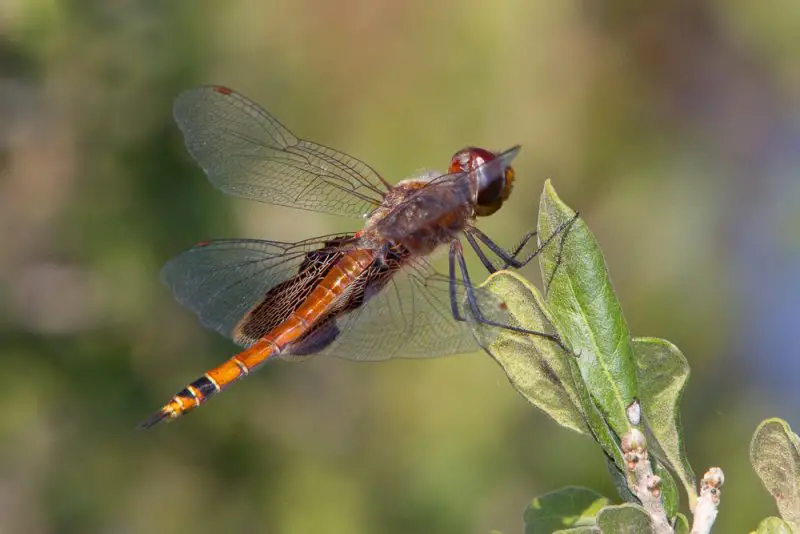
The Carolina Saddlebags closely resembles the Black Saddlebags but has a brighter appearance. Its hindwings feature bold red patches near the base, giving the look of red “saddlebags.” The body is dark, often appearing brownish-black, with reddish highlights on the abdomen. They are slightly smaller than their black relatives, averaging around 2 inches long.
Identification is easiest when they are in flight, as the red patches on the wings catch the sunlight and make them stand out. While perched, their long abdomen often tilts downward, another helpful trait for recognition.
This species is a powerful flier and spends much of its time in the air. Like the Black Saddlebags, they are excellent aerial hunters, catching prey while gliding. They are also known to migrate in groups, particularly in late summer and early fall, sometimes seen in mixed flocks with other migratory dragonflies.
In Illinois, Carolina Saddlebags are most common around still water such as ponds, marshes, and lakes. They prefer sunny, open areas and are often observed soaring above the water surface or patrolling grassy fields nearby.
Halloween Pennant (Celithemis eponina)
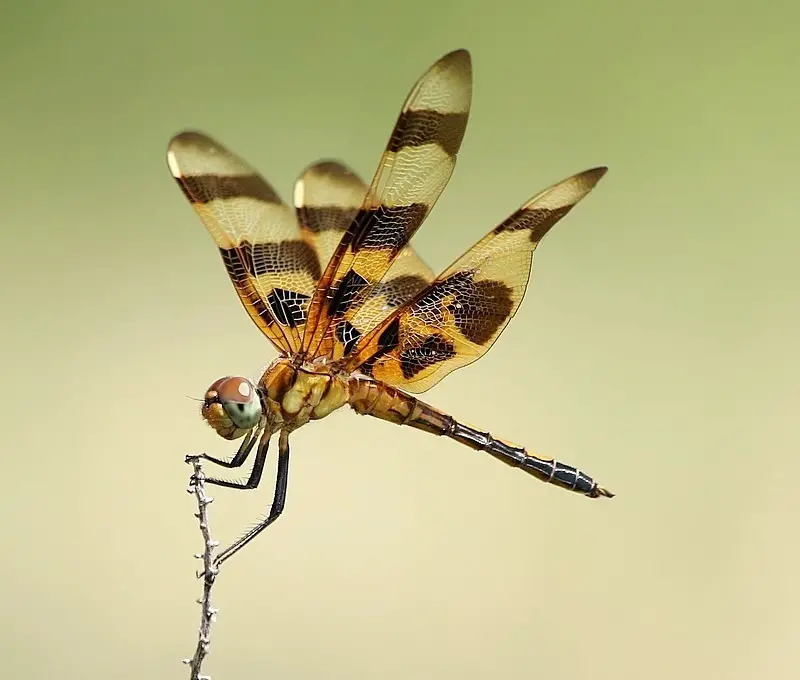
The Halloween Pennant is one of the most colorful dragonflies in Illinois. It has orange-yellow wings decorated with brown or black bands, giving it a festive, pennant-like appearance. Its body is slender and often displays orange and black coloration as well. With a wingspan of about 2 inches, it is a medium-sized but very eye-catching species.
Their appearance is unmistakable, as the patterned wings look like miniature stained glass when sunlight shines through. When perched, they often hold their wings spread like butterflies rather than folded upward, making them easier to distinguish.
Halloween Pennants are known for their graceful, fluttering flight, which resembles that of a butterfly. Unlike fast-flying dragonflies, they often hover or glide gently over fields and ponds. They are skilled hunters of small insects, including mosquitoes and gnats, and often hunt in groups.
In Illinois, this species thrives in warm, open wetlands and grassy areas near ponds and lakes. They are most active in the height of summer and are a favorite among observers due to their striking colors and delicate flight patterns.
Banded Pennant (Celithemis fasciata)
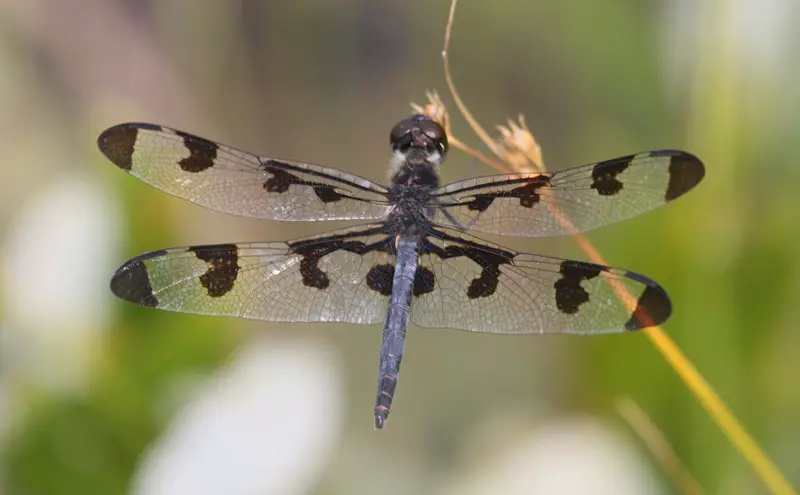
The Banded Pennant is another attractive species found in Illinois, recognized by its pale blue body and dark, broad bands across its wings. Males typically show a powdery blue abdomen, while females and young males are more brownish with yellow striping. Their wings are marked with several dark patches that form a banded appearance.
They are relatively small dragonflies, about 1.5 to 2 inches in length, but their wing markings make them stand out. Banded Pennants often perch on tall grasses or reeds, facing into the wind and balancing like a small flag, which is how they earned the name “pennant.”
Behaviorally, Banded Pennants are sit-and-wait predators. They perch often, darting out to capture prey such as flies and mosquitoes. Males are territorial and frequently return to the same perch after short hunting flights, making them predictable to spot.
In Illinois, they inhabit ponds, marshes, and slow-moving streams during summer months. They are particularly common in sunny, open areas with abundant vegetation, where their perching behavior makes them visible to patient observers.
Slaty Skimmer (Libellula incesta)
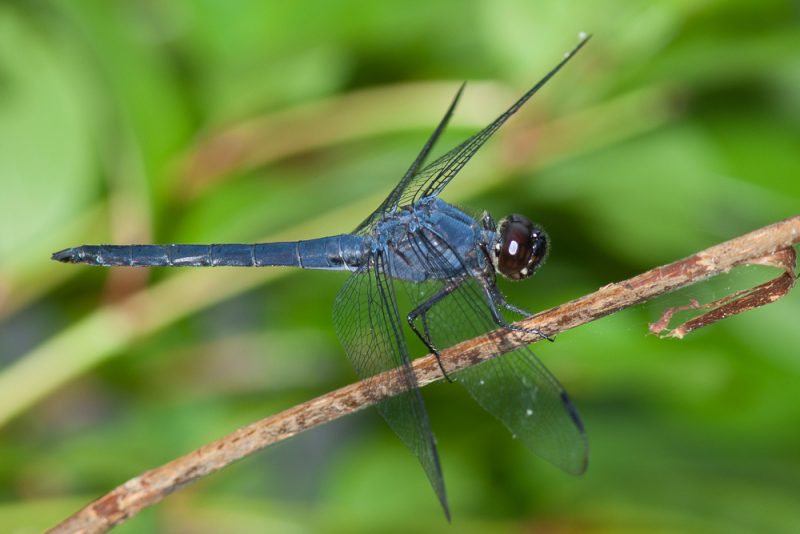
The Slaty Skimmer is a sleek and attractive dragonfly commonly found across Illinois. Adult males are a uniform slate-blue color with dark wingtips, while females are brown with yellow striping along the abdomen. Their wings are clear, lacking the large patches seen in skimmers like the Widow or Twelve-spotted Skimmer.
They grow to about 2.2 inches long and have a streamlined, elegant appearance. The uniform blue coloration of mature males makes them easy to distinguish from similar dragonflies, especially when perched on reeds or sticks near water.
Slaty Skimmers are territorial hunters. Males defend small patches of shoreline or emergent vegetation, often perching on the same spot repeatedly. They capture small insects in flight, including mosquitoes, flies, and gnats, which they eat while still on the wing.
In Illinois, they are typically found near ponds, lakes, and quiet streams with ample emergent plants. They are most active in midsummer and are commonly seen perched low over water or gliding across calm surfaces. Their even coloration makes them a subtle but elegant presence in wetland habitats.
Spangled Skimmer (Libellula cyanea)
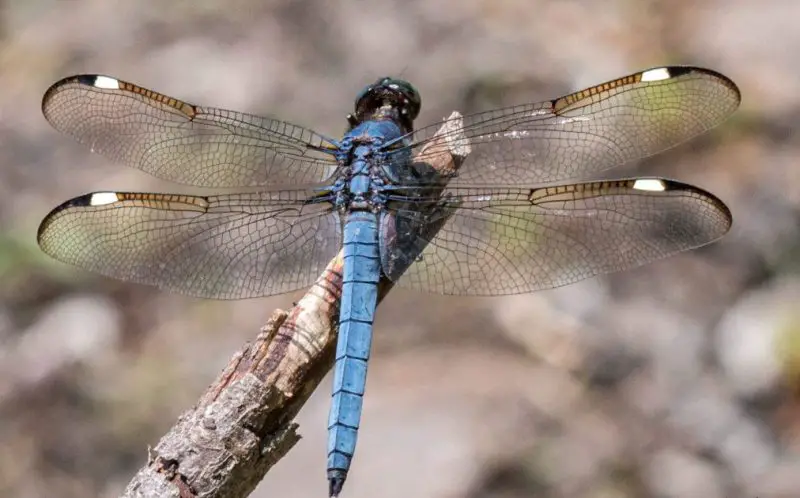
The Spangled Skimmer is a medium-sized dragonfly known for its striking wing markings. Males have a powdery blue body, while females are brown with yellow striping along the abdomen. Both sexes feature small, reflective white patches called “stigmata” on their wings, which glisten in sunlight and help with identification.
They average about 2 inches in length, with broad wings that give them a sturdy appearance. The bright blue coloration of males contrasts sharply with the wing reflections, making them easy to recognize even from a distance. Females, though less colorful, are still distinctive thanks to the spangled wing patches.
Behaviorally, Spangled Skimmers are perch hunters. They often rest on reeds or branches near the water and fly out quickly to catch prey. Their diet includes mosquitoes, flies, and other small insects. Males are territorial and defend small patches of shoreline or vegetation from rivals.
In Illinois, they are common during summer months in ponds, lakes, and slow-moving streams. They prefer habitats with plenty of emergent vegetation where they can perch and patrol. Their shimmering wing patches make them a favorite among dragonfly enthusiasts.
Eastern Amberwing (Perithemis tenera)
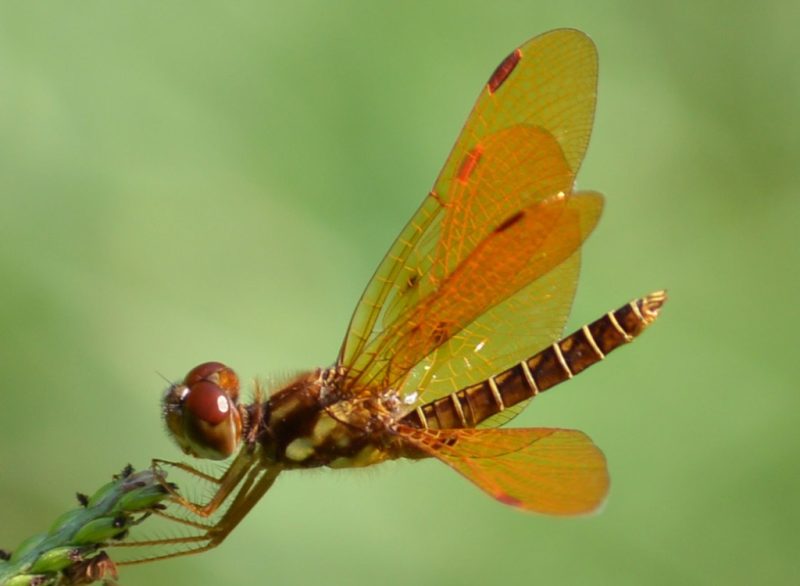
The Eastern Amberwing is one of the smallest dragonflies in Illinois, measuring only about 1 inch long. It is easily identified by its golden-orange body and amber-colored wings, which glow in the sunlight. Despite its small size, its bright coloration makes it quite noticeable around water.
Males and females look similar, though males are slightly more vibrant in color. The amber wings set this species apart from most others, as few dragonflies in Illinois have such distinctly colored wings. They resemble small wasps in flight, which may help protect them from predators.
Eastern Amberwings are active hunters, feeding on tiny insects such as gnats and mosquitoes. Unlike larger dragonflies, they often patrol low over the water in short, darting flights. Males are territorial and will chase away rivals from preferred perches near the shoreline.
In Illinois, this species is widespread and thrives in ponds, lakes, and marshes during summer. They are especially common in calm, sunny areas where aquatic vegetation provides perching spots. Their bright amber wings make them one of the most attractive small dragonflies in the state.
Blue Corporal (Ladona deplanata)
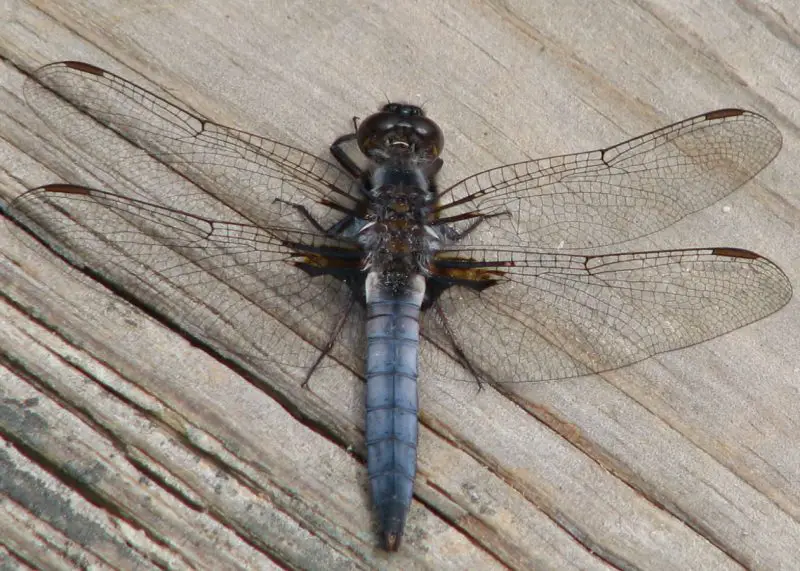
The Blue Corporal is a small to medium-sized dragonfly with unique markings. Males develop a powdery blue coloration on the body, while females remain brown. Both sexes have two bold dark stripes running along the thorax, resembling military insignia, which is how the species earned its common name.
They measure about 1.5 to 2 inches in length. The combination of thoracic stripes and compact size makes them easy to identify, especially when perched on bare ground or vegetation. Their wings are clear with a slight smoky tint near the base.
Blue Corporals are perch-and-wait hunters. They spend much of their time resting on logs, rocks, or ground near water, darting out to snatch small flying insects. Males defend territories but are not as aggressive as some other dragonfly species.
In Illinois, they are often among the earliest dragonflies to appear in spring, making them a welcome sight after winter. They prefer ponds, lakes, and slow rivers with sandy or muddy shorelines. Their early flight season distinguishes them from many other dragonflies in the region.
Lancet Clubtail (Gomphus exilis)
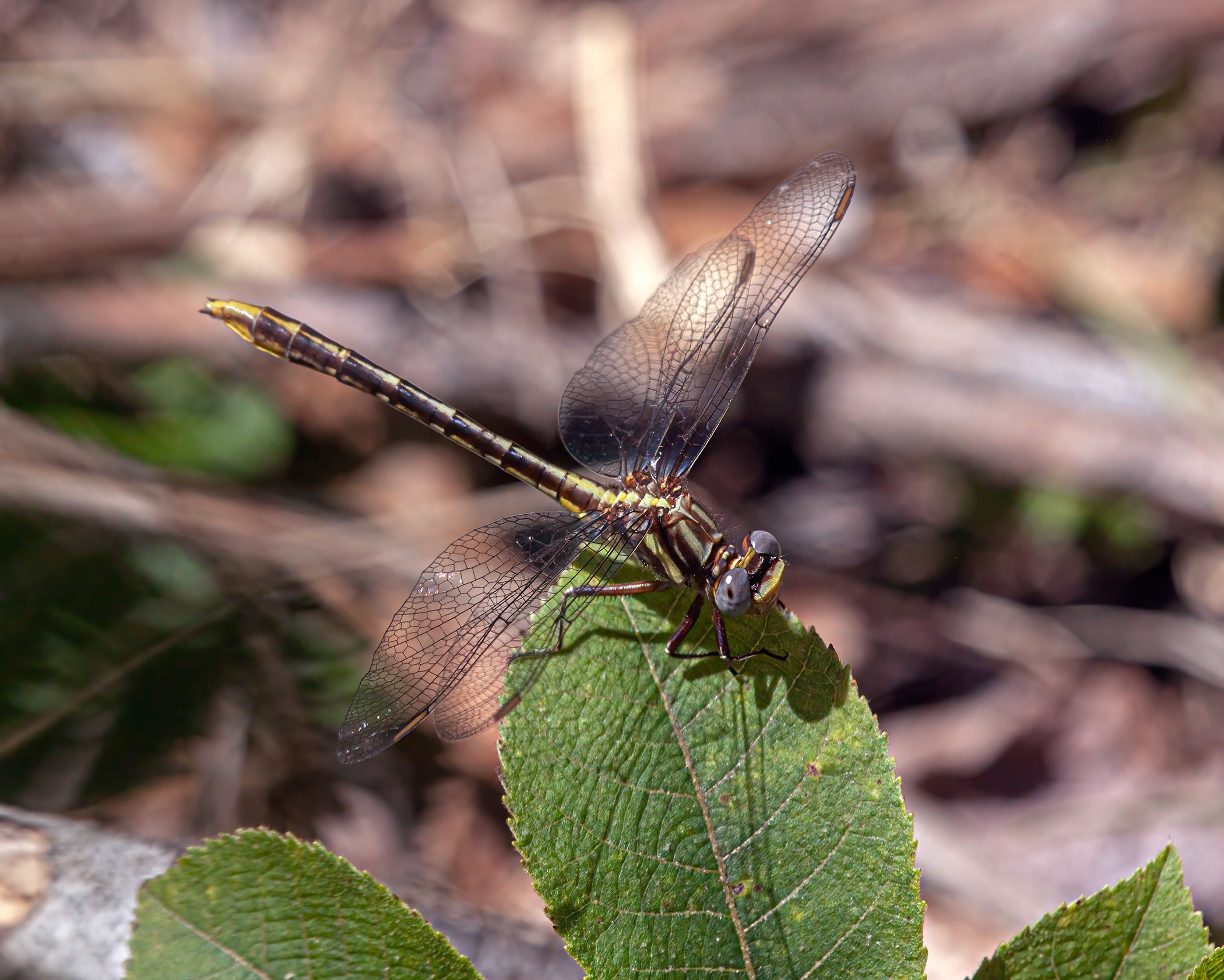
The Lancet Clubtail is a slender dragonfly recognized by the slight club-shaped widening at the end of its abdomen. It has a greenish-yellow thorax with dark stripes and a mostly black abdomen marked with yellow spots. Adults measure around 2 inches long, making them medium-sized among dragonflies.
Their clubbed abdomen is less pronounced than in some other clubtail species, but still noticeable upon close inspection. They also have widely separated eyes, a common trait in the clubtail family, which helps differentiate them from skimmers and darners.
Behaviorally, Lancet Clubtails are active hunters that fly low over streams, rivers, and lakeshores. They often perch flat on the ground, rocks, or low vegetation, which makes them more challenging to spot compared to species that perch upright on reeds.
In Illinois, they are most often found along clear rivers and lakes during early to mid-summer. They prefer habitats with sandy or gravel bottoms where their aquatic larvae can thrive. Their discreet habits make them less frequently observed than more conspicuous dragonflies.
Ashy Clubtail (Gomphus lividus)
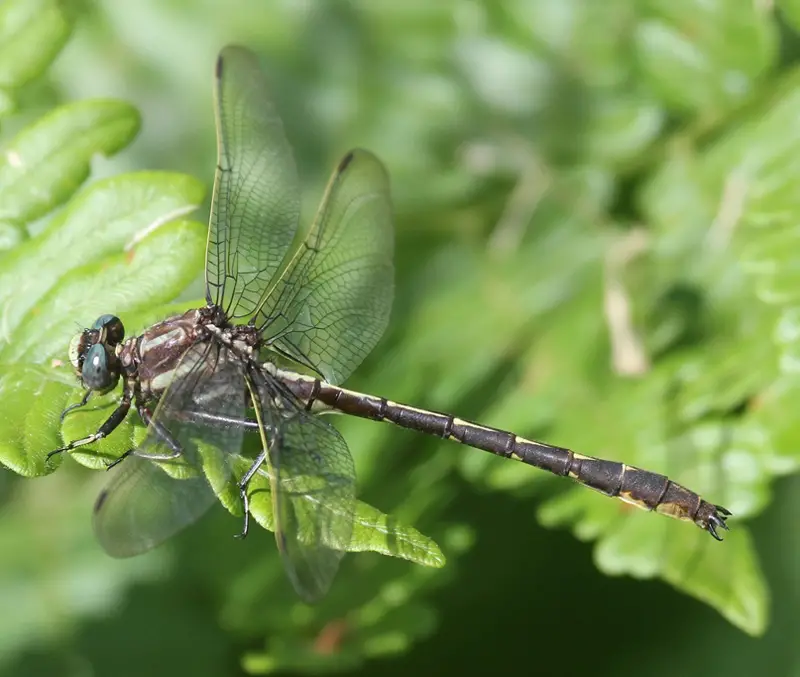
The Ashy Clubtail is a medium-sized dragonfly with a muted, grayish appearance. Its thorax is brownish-gray with subtle stripes, and its abdomen is dark with pale yellow markings. The end of the abdomen is slightly clubbed, though not as exaggerated as in some related species. Adults grow about 2 inches long.
They are relatively inconspicuous compared to more colorful dragonflies, but their subdued tones help them blend into sandy or gravelly environments. Their clear wings and separated eyes also aid in identification.
Ashy Clubtails are strong fliers and often patrol low over rivers and streams. They perch frequently on rocks, sandbars, or bare soil, making them more visible to careful observers. Their diet consists of small flying insects, which they catch during short, fast flights.
In Illinois, this species inhabits rivers, streams, and occasionally lakes with clean, sandy bottoms. They are most active from late spring through summer. Their preference for flowing water habitats makes them less common in stagnant ponds compared to other dragonflies.
Rapids Clubtail (Phanogomphus quadricolor)
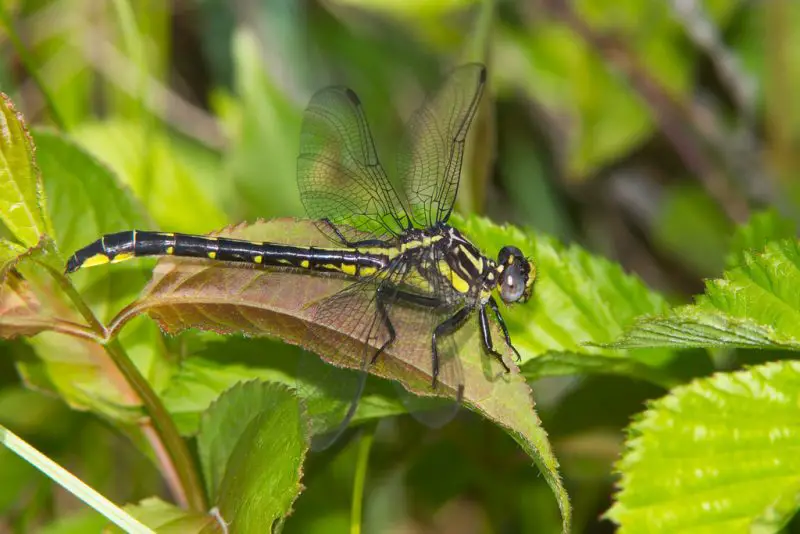
The Rapids Clubtail is a slender dragonfly adapted to fast-flowing streams and rivers. It has a greenish thorax with black stripes and a mostly black abdomen marked with yellow rings. The abdomen ends with a modest club shape, making it recognizable among other dragonflies. Adults average about 1.8 to 2 inches long.
Identification features include widely separated eyes and bold yellow markings on the abdomen. Unlike more colorful species, the Rapids Clubtail has a muted but sharp pattern that blends well with rocky stream environments. Its clear wings and low-flying behavior also help confirm its identity.
This species is an agile hunter, staying close to the water surface and capturing small insects in flight. They are not often seen perched high on plants; instead, they rest on sandbars, rocks, or low vegetation near the riverbanks. Their flight is quick and direct, often hugging the water’s edge.
In Illinois, the Rapids Clubtail is typically found in clean, fast-flowing rivers with gravel or rocky bottoms. They are most active from late spring through summer. Because they rely on unpolluted water, their presence is often an indicator of good stream health.
Cobra Clubtail (Gomphus vastus)
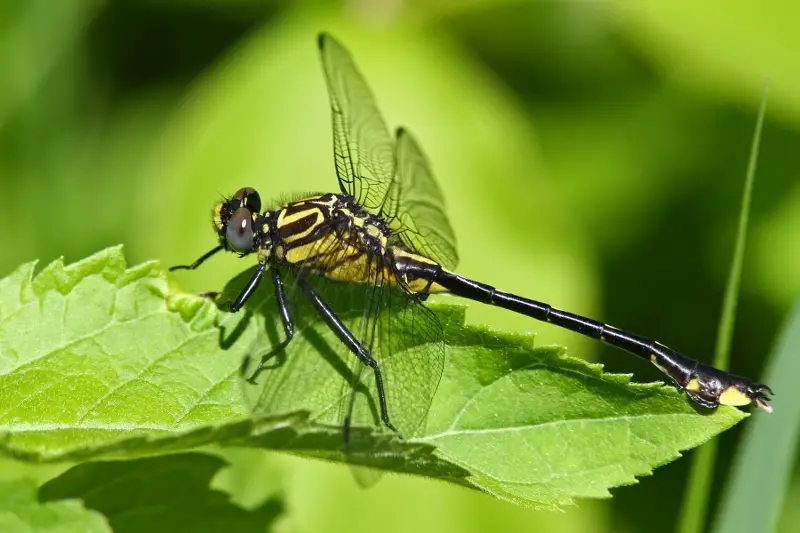
The Cobra Clubtail is a large and distinctive dragonfly in Illinois. Its name comes from the swollen thorax, which resembles a cobra’s hood when viewed from above. The body is mostly dark with pale yellow striping, and the abdomen ends with a slightly enlarged club. Adults reach about 2.5 inches in length, making them larger than many other clubtails.
It can be identified by its size, greenish-yellow thorax with strong black lines, and the robust clubbed abdomen. Its widely spaced eyes also mark it as a member of the clubtail family. When perched, it often spreads its wings flat and holds the abdomen slightly raised.
The Cobra Clubtail is a strong flier that patrols stretches of rivers, searching for prey. It typically flies low and fast, capturing insects midair. Males are territorial and often return to the same perching spots along riverbanks to defend their hunting area.
In Illinois, this species is closely tied to large rivers with sandy or muddy bottoms. It emerges in late spring and early summer, making it a seasonal highlight for dragonfly watchers along the Illinois and Mississippi Rivers.
Midland Clubtail (Phanogomphus fraternus)
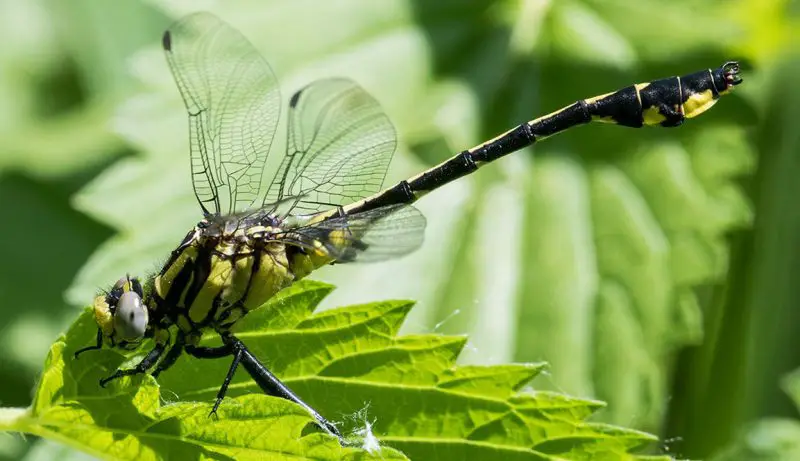
The Midland Clubtail is a medium-sized dragonfly common across much of Illinois. Its thorax is olive green with black stripes, and the abdomen is mostly black with yellow markings and a modest club at the end. Adults measure about 2 inches long, making them similar in size to the Lancet Clubtail.
This species is relatively easy to identify by the sharp yellow and black patterning along the abdomen and the club-shaped tip. Its eyes are distinctly separated, another hallmark of clubtails. When perched, they usually rest on bare ground, logs, or low plants.
Behaviorally, Midland Clubtails patrol slowly over rivers, streams, and lake margins. They perch often between flights and capture small insects in quick aerial pursuits. Males are territorial and may chase away rivals from favored perching areas.
In Illinois, they are widely distributed and favor habitats with sandy or gravelly bottoms. They are most active from late spring through early summer. Because they are common and perch frequently, they are one of the easier clubtail species to observe.
Arrow Clubtail (Stylurus spiniceps)

The Arrow Clubtail is a slender and elegant dragonfly, named for its long abdomen that tapers like an arrow. It has a greenish thorax with black stripes and a dark abdomen with yellow spots. The club at the end is less pronounced than in other clubtails, giving it a sleek, streamlined appearance. Adults are about 2.5 inches long.
Its arrow-like body and narrow build make it easy to recognize. Unlike many other clubtails, it is often seen perched on overhanging branches or leaves above the water, giving observers better viewing opportunities. Its eyes are widely separated, as with all clubtails.
Arrow Clubtails are strong, fast fliers that patrol large rivers and streams. They often perch between flights, sometimes high above the water, unlike most other clubtails that stick to the ground or low vegetation. Their hunting style involves quick pursuits of midges, flies, and mosquitoes.
In Illinois, this species is most often found along large rivers with clean, sandy bottoms. They are active in summer, especially in July and August. Their tendency to perch high makes them more noticeable than some of their clubtail relatives.
Stream Cruiser (Didymops transversa)
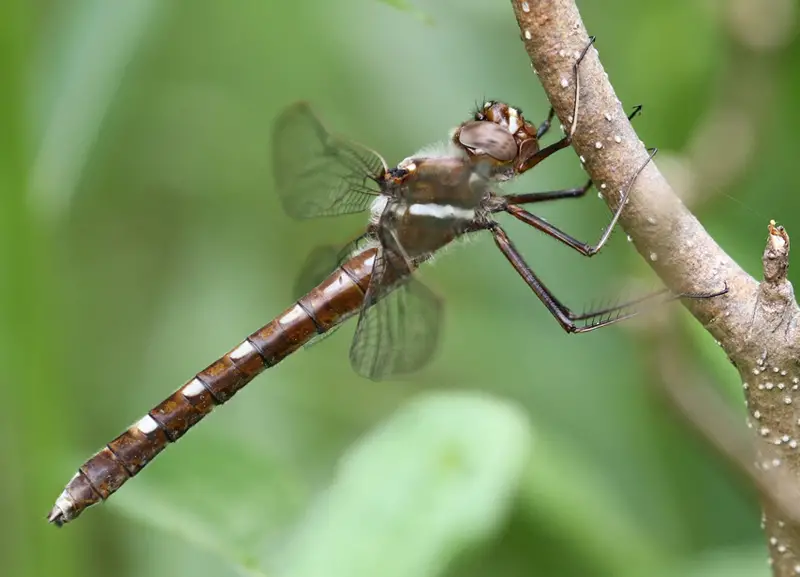
The Stream Cruiser is a large, dark dragonfly with distinctive markings. Its thorax is brown with yellow stripes, and its long abdomen is dark with pale spots. Adults average about 2.5 to 3 inches in length, making it one of the larger dragonflies in Illinois.
Identification is aided by its long, narrow body and clear wings with a slight amber tint near the base. The Stream Cruiser’s strong, cruising flight pattern over rivers and streams also helps distinguish it from other dragonflies.
Behaviorally, this species spends much of its time flying continuously over water, rarely perching for long. They patrol long stretches of rivers and streams, feeding on small flying insects they catch midair. Because of their constant movement, they can be more challenging to observe closely.
In Illinois, the Stream Cruiser inhabits clear rivers, streams, and occasionally large lakes with forested shorelines. They are active from spring through mid-summer. Their preference for moving water and continuous flight make them a striking presence in river habitats.
Prince Baskettail (Epitheca princeps)
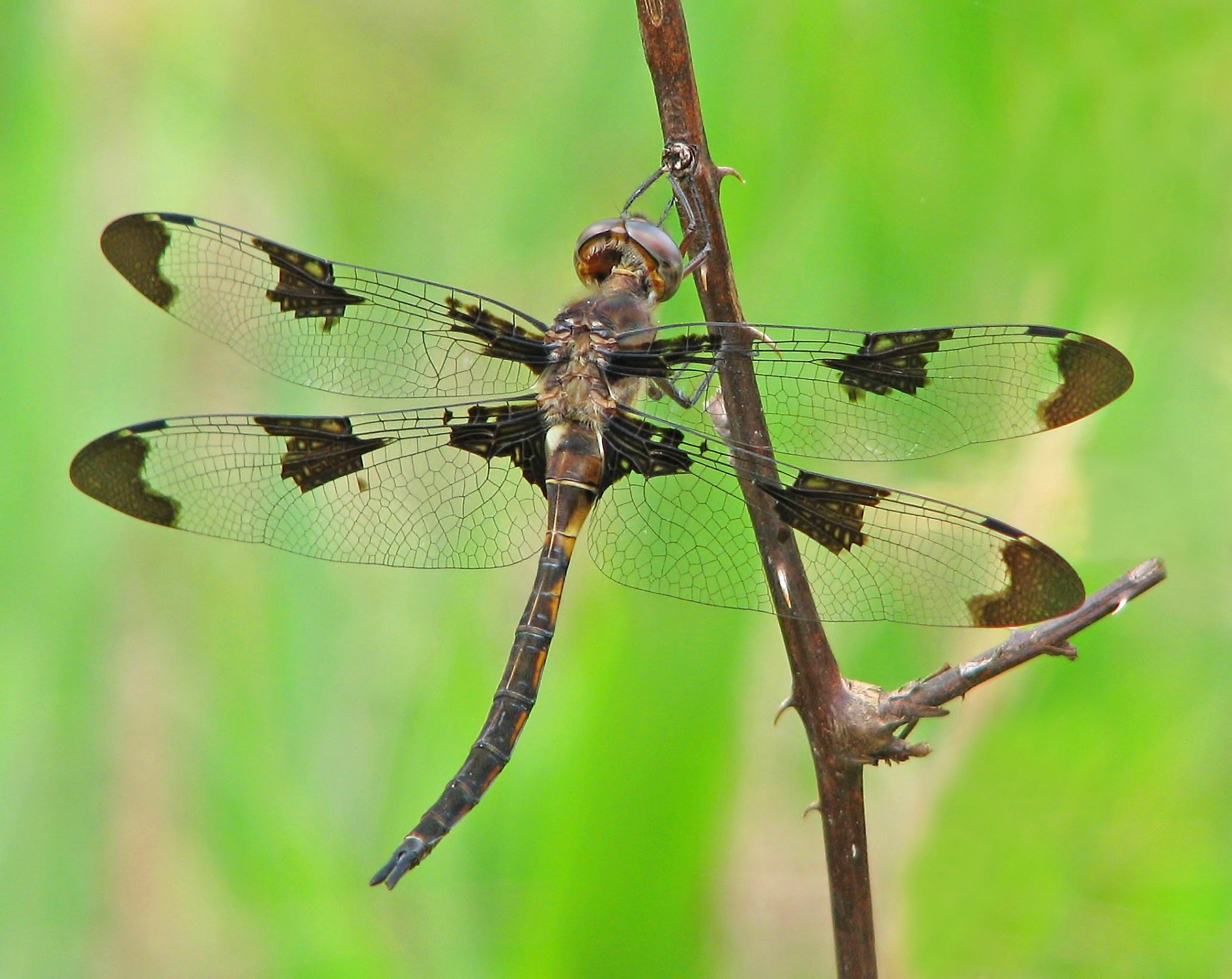
The Prince Baskettail is one of the most striking large dragonflies in Illinois. It has a brownish thorax and abdomen, with bold dark bands across its otherwise clear wings. These wing markings make it easy to recognize while flying. Adults are fairly large, reaching about 2.5 to 3 inches in length.
Its long, slender abdomen and banded wings help distinguish it from similar baskettails. In flight, the broad dark wing bands give it a unique appearance, unlike the clear-winged skimmers and clubtails. When perched, its wings often remain slightly spread, showing off the markings.
Prince Baskettails are powerful fliers that patrol open water, often far from shore. They rarely perch for long, preferring to remain on the wing as they search for insects. Their diet includes mosquitoes, flies, and other small airborne insects.
In Illinois, this species is common in lakes, ponds, and large rivers during spring and summer. They are especially noticeable because of their large size and constant flight over open water, often patrolling higher than most other dragonflies.
Dot-tailed Whiteface (Leucorrhinia intacta)
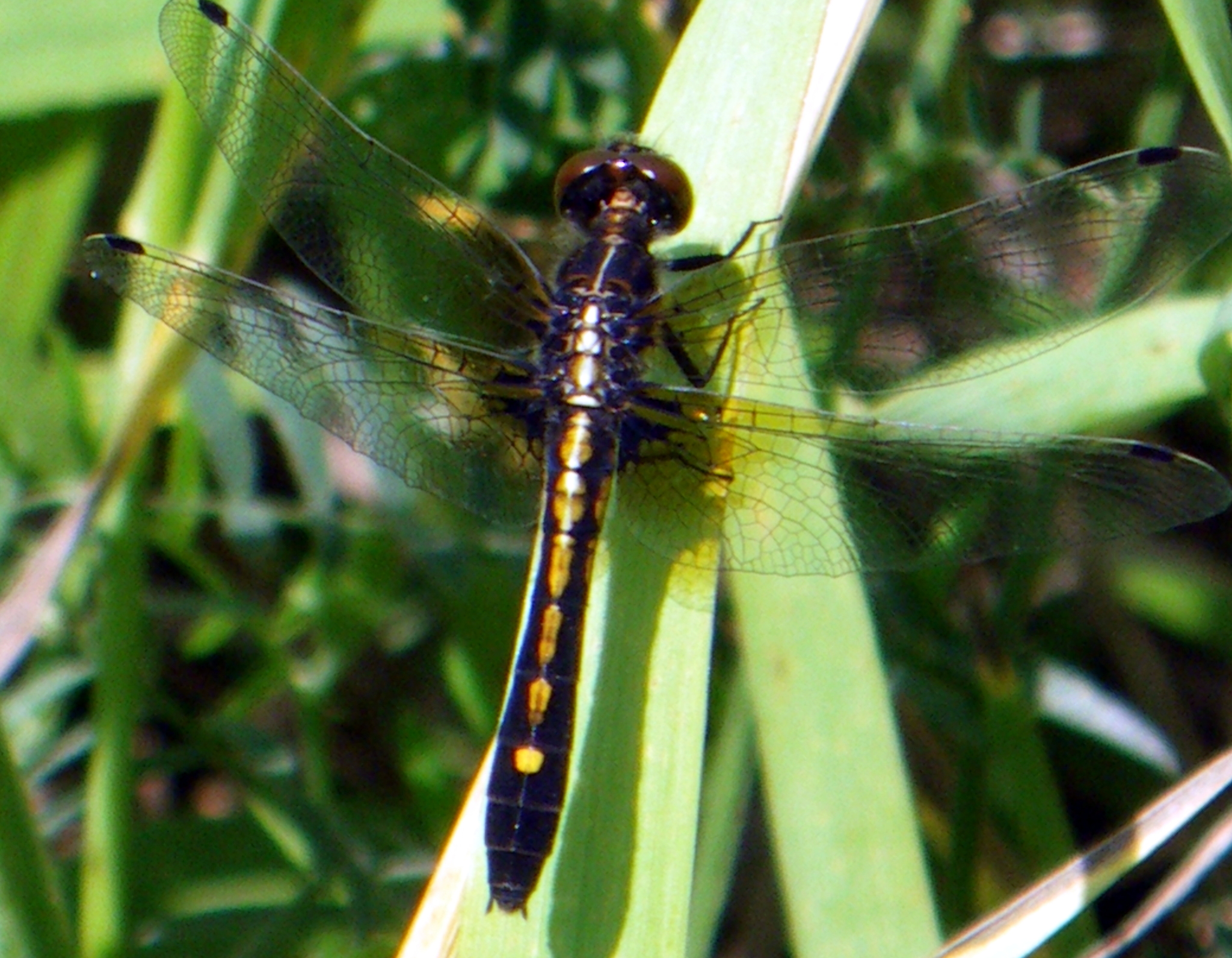
The Dot-tailed Whiteface is a small but distinctive dragonfly. Adults have a black body with a bright white face, giving the species its name. The abdomen features a single yellow spot near the tip, making identification straightforward. They are small, measuring about 1.2 to 1.5 inches long.
The white face is the most reliable identification feature, along with the yellow dot near the end of the abdomen. Their wings are clear with minimal markings, which further highlights the white facial coloration.
Dot-tailed Whitefaces are perch hunters, often resting on logs, lily pads, or low vegetation near ponds and marshes. They dart out to snatch small insects like gnats and mosquitoes before returning to their perch. Males are territorial and actively defend perching spots.
In Illinois, they are widespread in still-water habitats such as ponds, lakes, and boggy wetlands. They are especially common in summer and are a favorite among nature observers because of their bold facial marking.
Frosted Whiteface (Leucorrhinia frigida)
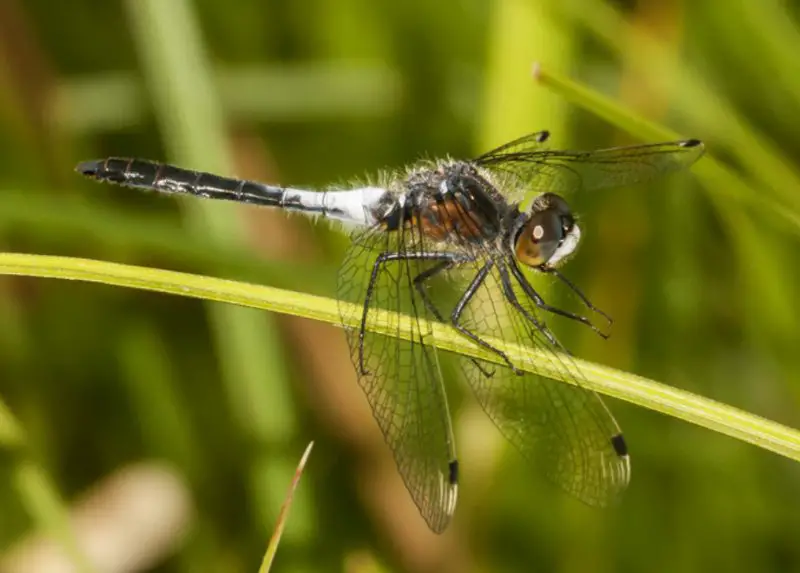
The Frosted Whiteface is another small member of the whiteface group, known for its frosted, pale-blue abdomen. Males develop a powdery, whitish-blue covering on the abdomen, while females remain darker with yellow markings. Adults measure about 1.5 inches long.
Their pale abdomen and clear wings with small black basal markings make them easy to distinguish. Like other whitefaces, they also have a bright white face that contrasts sharply with the dark body.
They behave similarly to the Dot-tailed Whiteface, perching often on floating vegetation or emergent plants. They hunt small insects such as midges, flies, and mosquitoes, making them effective predators in wetland environments.
In Illinois, they are found in ponds, lakes, and bogs, especially in the northern parts of the state. They are more localized than the Dot-tailed Whiteface but can be abundant where suitable habitats exist. Their frosted appearance makes them stand out among small dragonflies.
Cherry-faced Meadowhawk (Sympetrum internum)
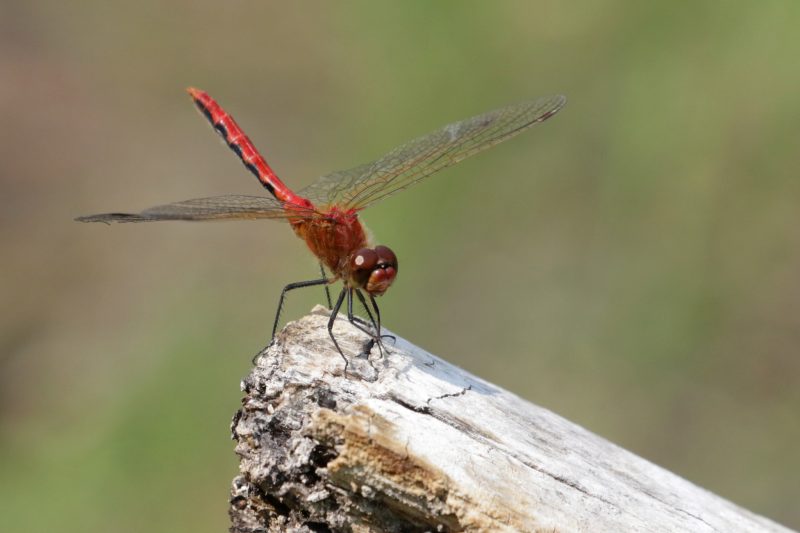
The Cherry-faced Meadowhawk is a medium-sized dragonfly with a vibrant red body in mature males. Females and young males are brownish with yellow striping before turning red as they mature. Adults measure about 1.5 inches long, making them smaller than skimmers but larger than whitefaces.
They can be distinguished from other meadowhawks by their bright red coloration, combined with dark legs and a slightly darker face. However, distinguishing them from closely related meadowhawks can be challenging without close inspection.
Cherry-faced Meadowhawks are aggressive hunters, capturing flies, mosquitoes, and other small insects midair. Males are territorial and perch on tall grasses or twigs while waiting for passing females. Their bold coloration and perching behavior make them highly visible in open habitats.
In Illinois, they are common in fields, meadows, ponds, and marshes during summer and early fall. They are especially abundant in sunny, grassy areas where they perch on tall stems to scan for prey.
Autumn Meadowhawk (Sympetrum vicinum)
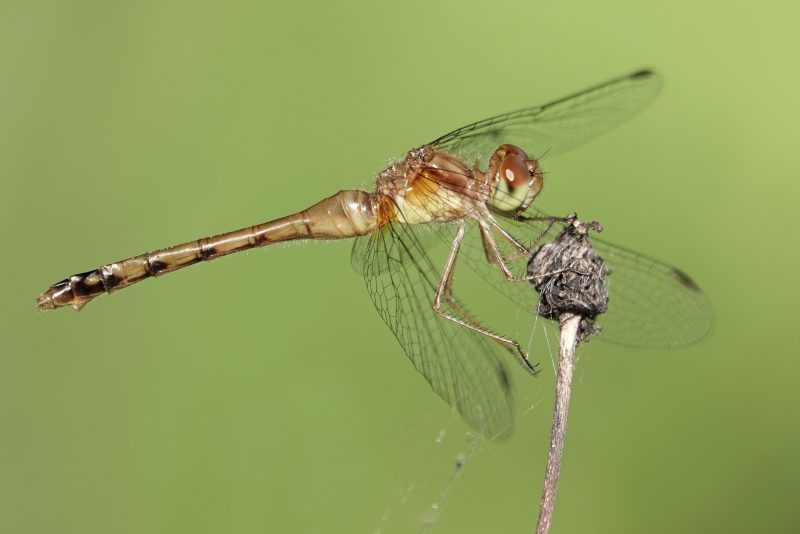
The Autumn Meadowhawk is one of the last dragonflies to remain active in Illinois, often flying well into October or even November. Mature males are bright red, while females are yellowish or tan with reddish highlights. Adults are small to medium-sized, about 1.3 to 1.5 inches long.
Their late-season activity is a key identification feature, along with their red coloration in males and yellow tones in females. Their wings are clear with small amber patches near the base, adding to their subtle beauty.
Autumn Meadowhawks are perch hunters that frequently rest on rocks, sticks, or low vegetation in sunny areas. They are less aggressive than some other meadowhawks but are persistent hunters, feeding on small flying insects late into the season.
In Illinois, they inhabit a wide range of habitats, including ponds, wetlands, meadows, and even urban parks. Their ability to survive into the cooler months makes them one of the most commonly seen dragonflies during autumn, when most other species have disappeared.
Best Time and Places to See Dragonflies in Illinois
Dragonflies in Illinois are most active during the warmer months, typically from late May through early October. Their peak activity usually occurs in mid-summer, when the weather is hot and humid. During this time, adults can be seen patrolling ponds, rivers, marshes, and meadows in search of food or mates.
The best time of day to observe dragonflies is during the late morning to mid-afternoon, when the sun is high, and temperatures are warm. Early mornings may offer opportunities to spot them perched with dew on their wings, while afternoons often showcase their agile flight patterns as they hunt.
Some of the best places to see dragonflies in Illinois include wetland preserves, state parks, and wildlife areas. Popular locations include the Illinois River valley, Shawnee National Forest, Lake Michigan shoreline, and local conservation areas with ponds and marshes. These areas provide the still or slow-moving water habitats that dragonflies prefer for hunting and breeding.
FAQs about Dragonflies in Illinois
What do dragonflies eat in Illinois?
Dragonflies primarily feed on mosquitoes, flies, midges, and other small flying insects. They are excellent hunters, catching their prey in mid-air with impressive precision.
Are dragonflies dangerous to humans?
No, dragonflies are harmless to humans. They do not sting or bite people. Instead, they play a beneficial role by controlling mosquito and pest populations.
How long do dragonflies live in Illinois?
The dragonfly life cycle lasts about 6 months to several years, with most of their time spent as aquatic nymphs. As adults, they typically live only a few weeks to a few months.
Do dragonflies prefer certain habitats in Illinois?
Yes, dragonflies are most often found near freshwater habitats such as ponds, lakes, rivers, and marshes. They rely on these areas for breeding and feeding.
Can you attract dragonflies to your backyard in Illinois?
Yes, creating a small garden pond or water feature can attract dragonflies. Native aquatic plants and sunny open spaces will make the habitat even more appealing.




